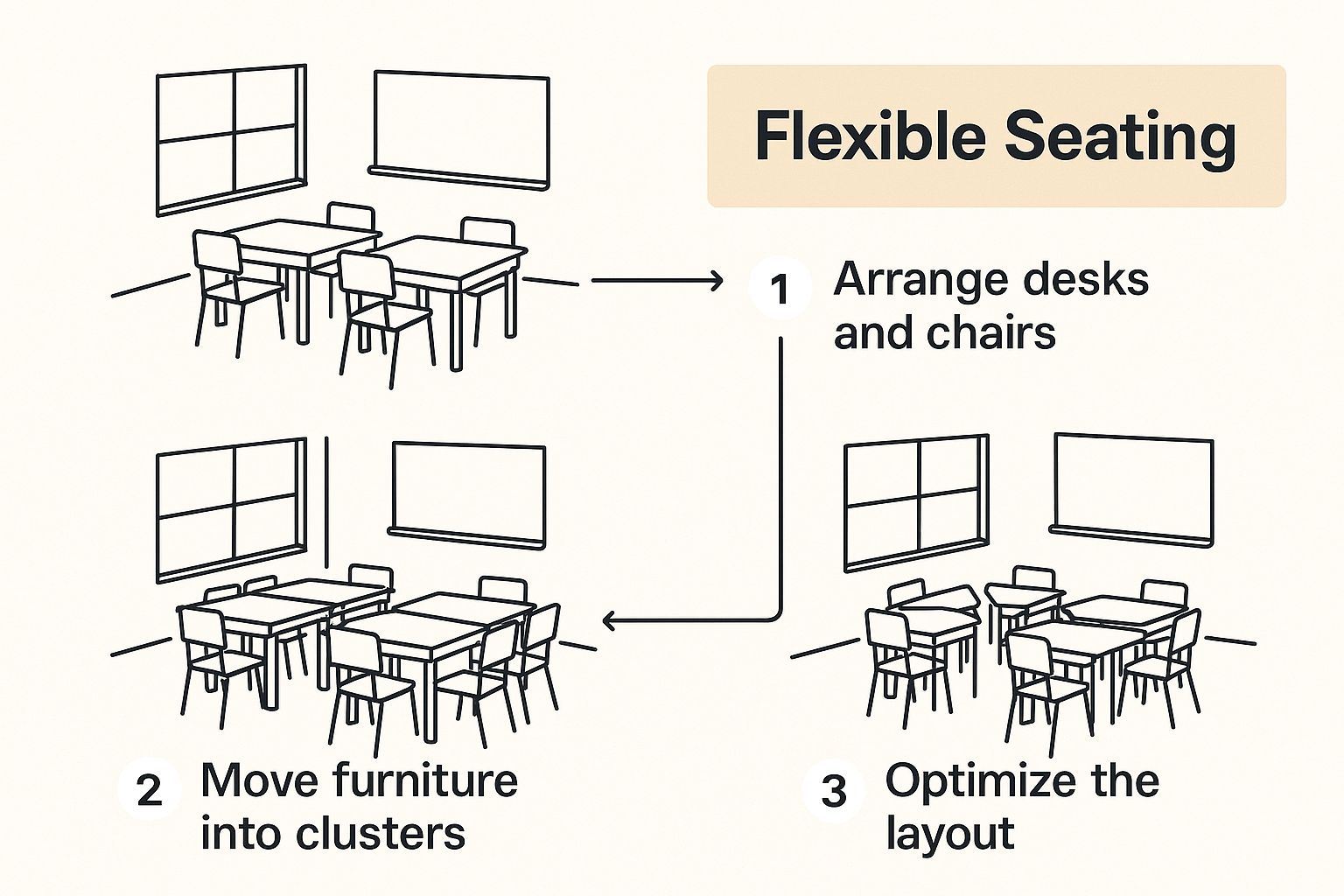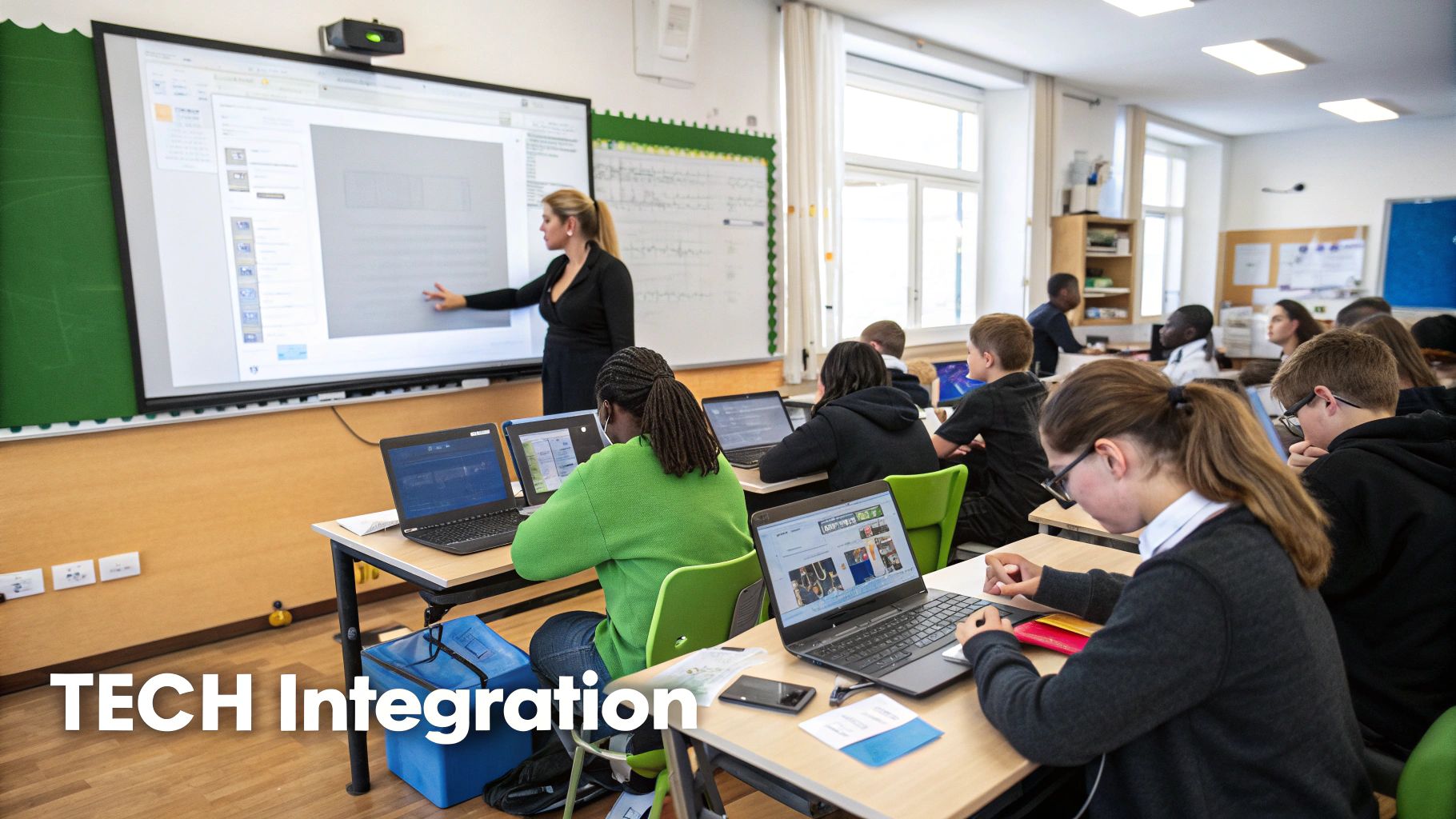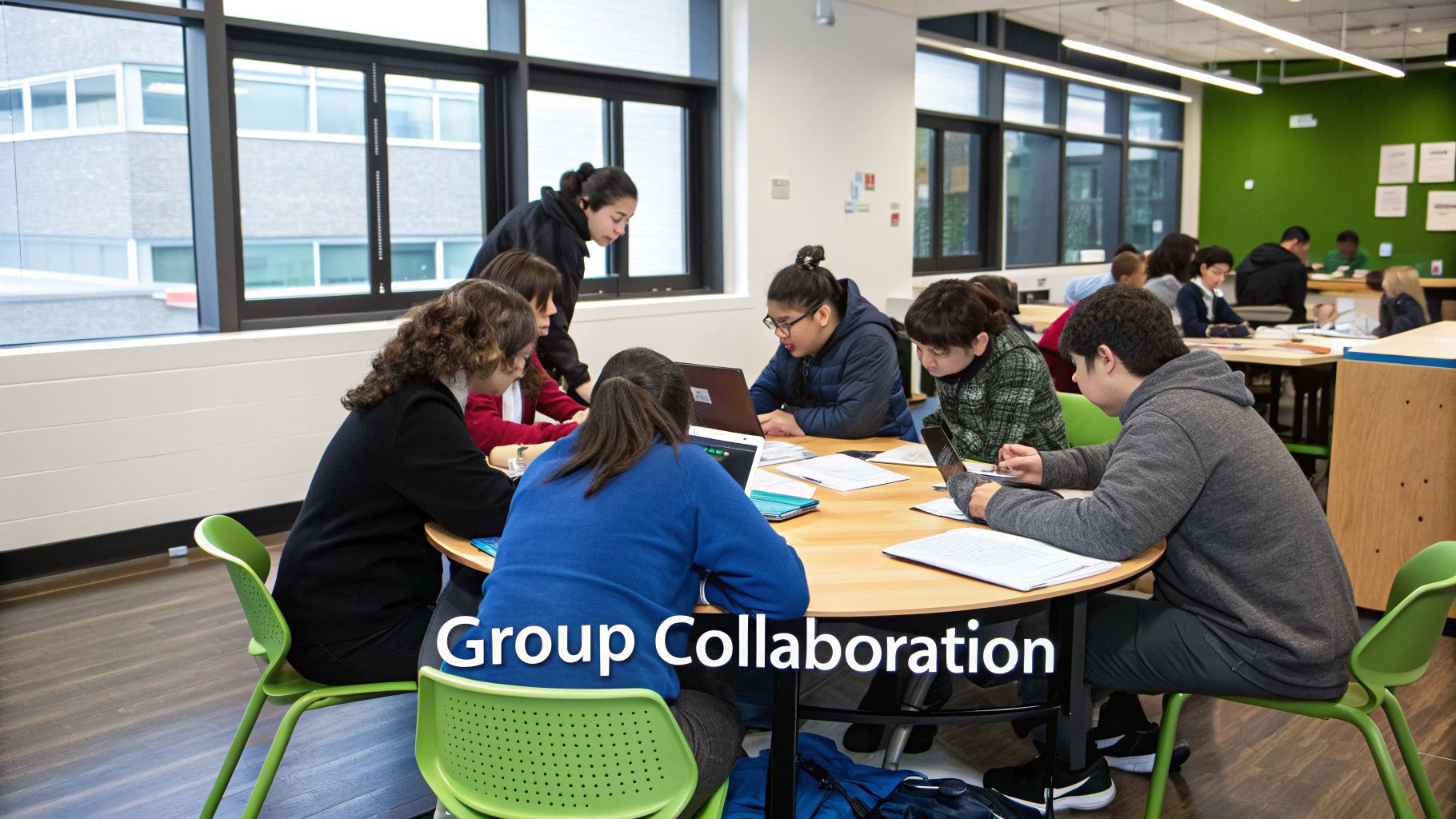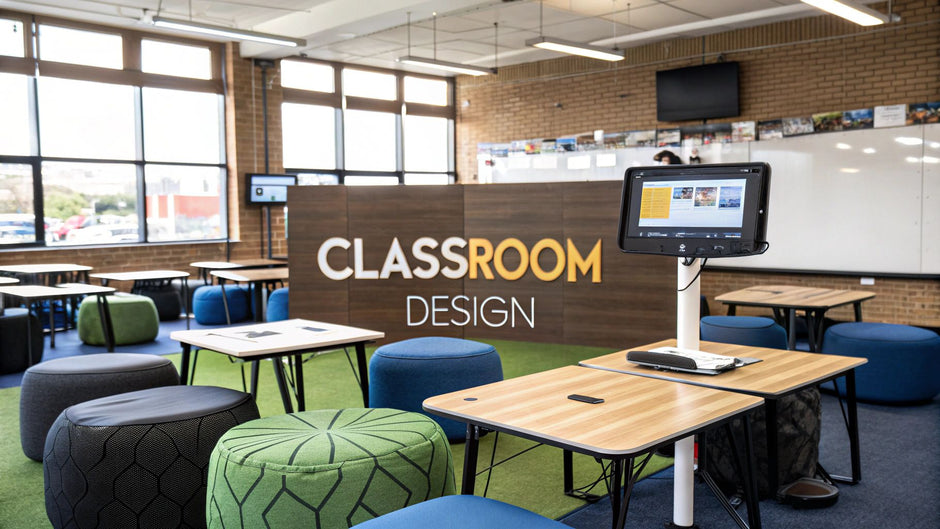Gone are the days when a classroom meant rigid rows of desks all facing a teacher at the front of the room. That old-school, lecture-focused setup was built for a different time—one where rote memorization was king. Today, we're all about fostering skills like critical thinking, collaboration, and creative problem-solving.
This massive shift in teaching philosophy calls for a physical environment that can actually support it. Modern classroom design isn't just about picking out new, colorful furniture; it's about building a space that empowers students and allows for a dozen different learning activities to happen all at once. The outdated model of students as passive listeners is out. The new model puts them right in the driver's seat of their own education. For a complete look at furniture and other solutions that can help bring this vision to life, you can explore our main collection on the topic.
Rethinking the Classroom Beyond Four Walls
The core idea behind a modern classroom is simple: the space itself should be as flexible and dynamic as the learning happening inside it. A room that can go from a quiet, focused reading nook to a buzzing hub for group projects in just a few minutes isn't a "nice-to-have" anymore—it's a necessity. This is how we accommodate all the different ways students learn and teachers teach.
"The classroom environment is often referred to as the 'third teacher.' A well-designed space can guide learning, foster community, and inspire curiosity just as effectively as an instructor or a peer."
This concept completely flips the one-size-fits-all approach on its head. Imagine a space where one group of students is huddled around a modular table for a hands-on project, while another is working quietly on laptops in a comfy soft-seating area. This kind of setup is a perfect match for newer teaching models. For instance, understanding how flipped learning classrooms operate can give you some incredible insights into designing these kinds of dynamic spaces.
From Static Rows to Dynamic Zones
Ultimately, the goal is to create an environment where students feel a real sense of ownership and control over how they learn. When a student can pick a workspace that clicks with their learning style and the task at hand, you see their engagement and focus skyrocket.
Making this transition from a static, fixed room to an agile, responsive environment is the cornerstone of modern education. If you're ready to start this transformation, a great first step is to explore a full collection of classroom and campus furniture for modern learning environments.
Mapping Your Space for Flexibility and Flow
Before you can build a dynamic learning environment, you need a solid plan. I always tell educators to start by looking at their current classroom not just for what it is, but for what it could be. Take stock of the fixed elements—windows, doors, built-in shelves—and then imagine everything else is a movable piece in a puzzle you get to solve.
This is where the idea of 'learning zones' becomes so powerful. A modern classroom doesn't treat the entire room as one big, open space. Instead, it carves it up into distinct, purposeful areas. This simple shift in thinking allows for multiple activities to happen at the same time without devolving into chaos.

The big takeaway here is that movement and choice are at the center of this new model. It’s all about transforming a static room into an interactive landscape where learning happens everywhere. I’ve found that this adaptability is the secret sauce for both effective classroom management and genuine student engagement.
To get a clearer picture of this shift, let's compare the old way with the new.
Traditional vs Modern Classroom Layouts
| Feature | Traditional Classroom | Modern Classroom |
|---|---|---|
| Layout | Fixed rows of desks facing forward. | Flexible, zoned areas for different activities. |
| Furniture | Static, heavy desks and chairs. | Mobile, modular, and varied seating options. |
| Teacher's Role | Instructor at the front of the room. | Facilitator moving between groups and zones. |
| Student Movement | Restricted and often disruptive. | Encouraged and purposeful. |
| Learning Style | Primarily lecture-based, one-size-fits-all. | Supports diverse activities (collaboration, solo work). |
| Technology | Centralized at the front (e.g., projector). | Integrated throughout the space. |
The contrast is stark. The modern approach isn't just about rearranging furniture; it's about fundamentally rethinking how learning happens and empowering students to take an active role in that process.
Creating Your Learning Zones
Think about the core activities that fill a typical day and then design specific zones to support them. You don’t need to build physical walls; a smart furniture arrangement, a few well-placed rugs, or even color-coding can do the trick.
Here are a few essential zones I recommend starting with:
- Collaboration Hub: A space with modular tables that can be easily pushed together for group projects.
- Quiet Corner: A cozy spot with soft seating for independent reading or focused work. I suggest placing this away from the door and other high-traffic areas.
- Creation Station: A hands-on area with easy access to supplies for projects, art, or STEM activities. Think of it as a mini-makerspace.
- Instruction Point: A small, designated area for direct teaching with a small group, often equipped with a whiteboard or interactive display.
This move toward flexible and adaptive learning spaces is one of the biggest trends I've seen in education. These spaces use modular furniture and layouts that can be quickly reconfigured to support anything from independent study to large group work. The impact is real—in fact, 78% of educators agree that flexible learning spaces positively impact student outcomes. You can learn more about how these classroom and school design trends are reshaping education.
A well-planned classroom minimizes disruptions. Before you finalize anything, walk the 'high-traffic' paths—from the door to the desks, to the supply station, to the exit. Make sure these pathways are clear and don't slice right through your quiet zones.
Involve Students in the Process
Finally, don't underestimate the power of bringing your students into the conversation. Ask them where they feel most focused or where they think they do their most creative work.
Giving them a voice in the layout builds a powerful sense of ownership. When students help design their learning environment, they're far more likely to respect it, take care of it, and feel truly comfortable in it. This simple, collaborative step turns the room into a shared community hub, not just a space they occupy for six hours a day. For a complete look at furniture and other solutions that can help bring this vision to life, you can explore our main collection on the topic.
Choosing Furniture That Fosters Engagement
The furniture you choose is the literal foundation of a modern classroom. Think about it: traditional, heavy desks bolted down in rows practically scream "sit still and listen." That’s a model built for passive learning.
To get students actively participating, you need furniture that’s just as agile and dynamic as the lessons you’re planning. This isn't about chasing trends; it's about giving students tools that invite movement, choice, and collaboration. When furniture can be moved and reconfigured on the fly, the room itself becomes a partner in the learning process.

Beyond the Standard Desk and Chair
One of the most powerful shifts you can make is introducing flexible seating. The whole idea is to offer a variety of options that work for different learning styles, different tasks, and different kids. Giving students that choice empowers them to figure out what environment helps them focus and do their best work.
So, what does that look like in practice?
- Wobble Stools: These are a lifesaver for kinesthetic learners who need to move to think. That little bit of motion can be a game-changer for focus, though they might not be the best pick for long writing assignments.
- Soft Seating: Beanbags, floor cushions, and small couches immediately create a more relaxed, welcoming vibe. They're perfect for setting up a quiet reading corner or a comfortable spot for small group discussions.
- High-Top Tables and Stools: Simply changing the height and posture can break up the monotony of a long school day. These are fantastic for small group activities or as a designated standing-work station.
- Floor Desks: Paired with some good cushions, low-to-the-ground lap desks are a great option for students who are most comfortable and focused working on the floor.
A quick pro-tip: when you first bring in flexible seating, you have to set clear expectations. Take the time to teach students how to choose a spot that fits the task and how to use each option properly. That little bit of structure is what ensures choice leads to productivity, not chaos.
The Importance of Mobile and Ergonomic Solutions
In a modern classroom, mobility is non-negotiable. Putting furniture on casters—from student tables to whiteboards and storage carts—is a simple change that allows for instant room transformations. A mobile bookshelf can act as a room divider for one activity and then roll out of the way to open up the space for the next.
Ergonomics are just as critical, especially with kids spending more and more time on devices. We need to think about furniture that supports healthy posture and adapts to growing bodies.
This is where things like sit-stand desks for educational settings can make a huge impact. Giving students the ability to easily switch between sitting and standing is a powerful way to boost alertness and support their physical well-being throughout the day. It’s a simple adjustment with big returns.
Ultimately, every piece of furniture should earn its spot in your classroom. Before you buy anything, ask yourself a few key questions: Does this support collaboration? Does it offer student choice? Can it be moved and repurposed easily? If the answers are yes, you’re on your way to investing in a classroom that truly works for your students.
Weaving Technology into the Classroom Fabric
In a modern classroom, tech should feel as natural to grab as a pencil. The goal isn't just to have gadgets, but to weave technology so deeply into the physical space that it becomes an intuitive tool for learning, not a clunky distraction. This means looking beyond the devices themselves and planning the entire tech ecosystem.
First up is device management. Forget the chaotic scramble for chargers at the end of the day. A well-designed room has student-friendly charging stations right where they're needed. This could be a simple mobile cart with power strips or secure cabinets that store and juice up laptops overnight. The point is, students can manage their own power needs, which builds responsibility and claws back precious instruction time.
Creating a Central Tech Hub
To stop a constant bottleneck around shared equipment, I always recommend setting up a dedicated 'tech hub.' This isn't just a closet for storage; it's an active zone for specific tasks.
Your hub could include things like:
- A small bank of shared laptops or tablets for students who might need one.
- A central printer that everyone knows how to use.
- Specialized gear, like a 3D printer, podcasting mics, or digital cameras.
By centralizing these tools, you establish clear procedures and a natural traffic flow. It prevents a pile-up and makes the hub a purposeful spot in your classroom layout.
The true test of great tech integration? When it's basically invisible. When a student can grab a device, find a plug, and get online without a second thought, you know the tech is serving the learning, not getting in the way.
Building a Rock-Solid Foundation
Of course, none of this works if the backbone is weak. The coolest devices in the world are just expensive paperweights if your infrastructure can't keep up. This is where planning the unseen parts of your classroom design is absolutely critical.
You need a strong, reliable Wi-Fi signal in every single corner of the room, from the quiet reading nook to the bustling group pods. Dead spots can completely torpedo a lesson. Just as important, power outlets have to be everywhere. Think about where students will actually be—along walls, in flexible seating areas, and near group tables. Installing floor outlets or bringing in mobile power towers can be a total game-changer, getting rid of hazardous extension cords and making power accessible for everyone.
This behind-the-scenes planning is what makes technology a true asset, not a frustrating obstacle.
For a closer look at the furniture and solutions that bring these ideas to life, you can explore our full collection for modern learning environments.
Designing for Wellness and Better Focus
A thoughtfully designed learning space does more than just look good; it actively supports the well-being of every single person inside it. When we talk about modern classroom design, we're recognizing that things like light, air quality, and sound levels have a direct, measurable impact on student health, mood, and their ability to concentrate. Creating a comfortable, calming atmosphere isn't just a "nice-to-have"—it's a foundational step toward deeper learning.
This means we need to start thinking about the sensory experience of the classroom. A space that feels good to be in naturally reduces stress and anxiety, paving the way for better academic performance. It's all about intentionally creating an environment where students don't have to fight against distractions and discomfort, freeing up their mental energy for what really matters.

Harnessing Natural Elements for Engagement
One of the most powerful—and cheapest—tools at your disposal is natural light. Study after study has shown that classrooms with plenty of daylight can boost student alertness and improve performance. A simple fix is to arrange your layout to maximize window access and keep those blinds open whenever you can.
Color also plays a subtle yet powerful role in setting the classroom's energy. While vibrant colors can be fantastic for stimulation in creative zones, calming tones like blues and greens are perfect for areas meant for quiet focus. Think of your color palette as another tool for guiding student behavior and mood.
This connection to the natural world is a key part of biophilic design, which weaves in elements like plants, natural materials, and views of green spaces. This approach is gaining traction for a good reason. With an estimated 20-25% improvement in student focus and a reduction in absenteeism linked to these designs, it's clear that wellness is becoming a non-negotiable part of the conversation.
Controlling Sound and Improving Air Quality
Distracting noise is one of the biggest hurdles to concentration. An acoustically comfortable classroom is essential, whether students are working alone or collaborating in groups. The good news? You don't need a major renovation to dampen sound.
Simple additions can make a huge difference:
- Soft Furnishings: Area rugs, fabric-covered chairs, and even curtains can absorb a surprising amount of ambient noise.
- Acoustic Panels: You can find decorative fabric panels to place on walls that reduce echo and create a much calmer auditory environment.
- Felt Dividers: Small felt dividers on tables or mobile partitions are great for creating sound-dampening micro-environments for focused work.
Likewise, improving air quality is a simple wellness win. Houseplants are a fantastic, low-cost way to naturally filter the air and bring a calming piece of nature indoors. Even just ensuring good ventilation by opening windows when possible can help keep everyone alert and engaged.
By proactively managing what students see, hear, and even breathe, you're removing invisible barriers to learning. You're creating a space that feels genuinely supportive and secure.
The Critical Role of Ergonomics
Finally, you can't talk about wellness in a modern classroom without talking about physical comfort. Ergonomics isn't just a buzzword for corporate offices; it's vital for students who spend hours sitting, writing, and using devices. Poor posture leads to discomfort, fidgeting, and a significant loss of focus.
This makes selecting furniture that supports healthy posture absolutely non-negotiable. We're talking about chairs that provide good back support and desks that are at an appropriate height. Adjustable-height furniture is an excellent investment, as it allows each student to find their optimal, comfortable setting. For a deeper dive into creating physically supportive workspaces, check out our full collection of ergonomic office and classroom solutions. By prioritizing ergonomics, you ensure the physical environment is helping, not hindering, your students' ability to learn.
Next Steps in Your Design Journey
Okay, you've got the vision. Now it's time to bring that modern classroom design to life, and that's where the real excitement begins. Whether you're planning a small refresh or a floor-to-ceiling overhaul, the key is to stay organized. I always recommend starting with a simple, prioritized checklist—it's the best way to focus your energy on the changes that will make the biggest impact first.
Getting everyone on board is your next big hurdle. When you talk to administrators, don't just talk about new furniture; talk about student outcomes. Explain how a flexible layout directly supports different learning styles and boosts engagement. For parents, frame it in a way that resonates with them—this new environment is designed to prepare their kids for the real-world, collaborative challenges they'll face after graduation.
Want a pro tip for building support? Show, don't just tell. Find success stories from other educators. Visuals of transformed classrooms and quick testimonials about how student focus improved are incredibly powerful and hard to argue with.
As you get into the nitty-gritty, especially if you're working with an older building, it helps to understand some basic renovation principles. You'd be surprised how much overlap there is. In fact, a practical guide to renovating old houses can offer some really clever insights into space transformation that apply just as well to a classroom.
Finally, remember you don't have to go it alone. Having a reliable partner can make all the difference between a project that stalls and one that succeeds. If you want to learn more about our company and why we're so committed to creating better learning environments, we invite you to explore our story and mission. We're here to help you every step of the way.
Common Questions About Classroom Redesign
Diving into a classroom redesign is exciting. You see the vision—a flexible, buzzing, student-centered space. But then the practical questions start flooding in. It’s one thing to dream it, another to actually make it happen. Let's walk through some of the most common hurdles I see educators face.
The biggest one? The budget. A full-room makeover with all-new furniture can seem completely out of reach for most schools. But a modern classroom design doesn't have to be an all-or-nothing project. You can absolutely start small. Try rearranging the furniture you already have to create distinct zones. Look into small grants that are specifically for innovative teaching tools or even just a few flexible seating options to get the ball rolling.
Another major hang-up is classroom management. The idea of students moving around freely, choosing their own spots... it can sound like a recipe for chaos. The secret is to treat this as a shift in your teaching approach, not just a physical change. Don't introduce everything at once. Bring in new seating options one at a time. More importantly, create clear expectations with your students on how to use each space for different kinds of work. This bit of structure is what turns choice into focus, not disruption.
Getting Everyone on Board
Getting your principal and parents on board is a critical piece of the puzzle. When you pitch your idea, don’t just focus on the cool new furniture. Lead with the "why." You have to frame the entire conversation around student outcomes.
Explain how a flexible classroom helps you differentiate instruction for every learner. Talk about how it builds real-world collaboration skills and gives students a sense of ownership over their learning. These are the skills they'll need for the rest of their lives.
A powerful strategy is to gather evidence. Share research on how flexible learning spaces can improve engagement and academic performance. Showcasing success stories from other schools can also make the benefits tangible and compelling for stakeholders.
Practical Implementation Concerns
Okay, so what about the nitty-gritty? Many educators get stuck on where to even begin or how to handle the logistics. You might be wondering about the durability of certain wobble stools, how to manage charging stations in a mobile setup, or the best way to introduce self-paced learning. These are the details that can make or break a smooth transition.
For answers to those kinds of specific questions, digging into a comprehensive FAQ page about educational and ergonomic furniture can be a huge help, offering direct solutions and valuable insights.
At the end of the day, creating a modern classroom is a process, not a one-time event. It’s all about responding to your students' needs and tweaking the space as you go. By tackling these common questions head-on, you can walk into your redesign project with a clear, confident plan.
At Mount-It, we believe in creating environments where students and educators can thrive. Explore our full range of ergonomic furniture and AV mounting solutions to build a classroom that fosters engagement, wellness, and a lifelong love of learning.
